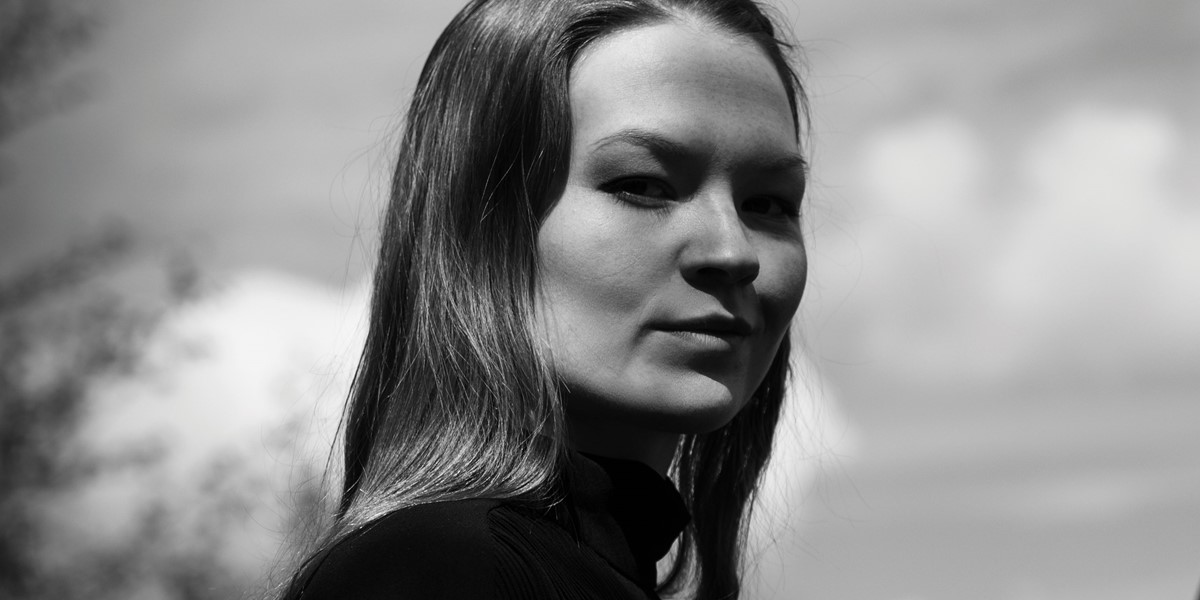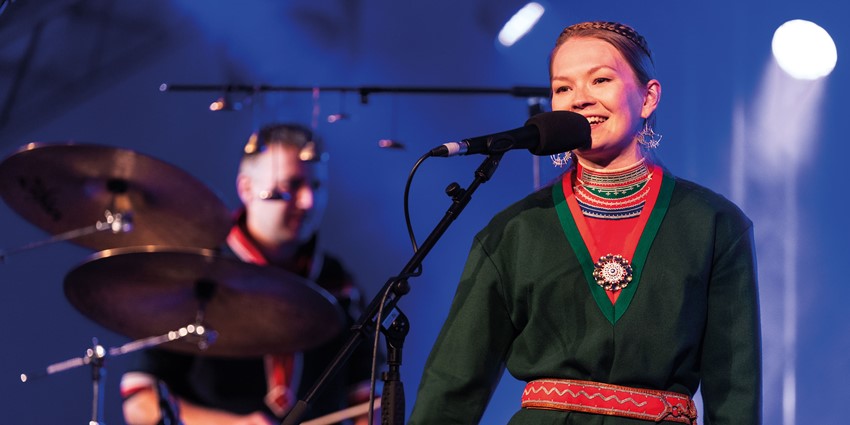Wednesday, January 26, 2022
Marja Mortensson: The Sámi Way
Around half of the 80,000 indigenous Sámi people live in Norway. Simon Broughton talks to one of the country’s rising musical stars, Marja Mortensson, about how she’s invigorating the joik tradition. Photos Knut Åserud & Tom Askew-Miller

When Sámi singer Marja Mortensson performed at WOMAD last summer, she began with a joik about the place she’s from, a reindeer-herding area in Norway called Svahken Sïjte. Her voice was quiet and slightly nasal, circling around the same repeated phrase with eerie overtones. Accompanied by just a drum kit and tuba, the whole set was one of last year’s WOMAD highlights, very original in its instrumentation but deeply traditional in its inspiration. The tuba and Mortensson’s often growly joik-style voice made a very striking pairing.
“I often start my concerts with this joik to my home area,” she says when I talk to her afterwards. “I’ve been raised in the tradition of reindeer herding and living close to nature, so when I go travelling it’s a way of bringing my home with me and bringing it to the stage.”
Mortensson’s speaking voice is surprisingly soft and smooth, because her singing or joiking voice is guttural and rich in nasal overtones. “I’ve been imitating the sound that ladies were doing in the old recordings, but they were maybe 60 or 70 years old. So it’s a mixture of that and my own anatomy that dictates the way I sound when I’m joiking,” she says.
Svahken Sïjte, where Mortensson (now in her mid-20s) was brought up, is near Lake Femund, halfway between Oslo and Trondheim, close to the eastern border with Sweden. But she lives further south where she went to her nearest high school about an hour north of Oslo. Her father is a reindeer herder and her mother a teacher. The South Sámi culture she belongs to suffered much more destruction from Norwegianisation than that of the north, simply because it was closer to the centre of power.
“I don’t understand how we survived: the language was banned, our drums were burned and there was this attack on ‘witches’ and ‘shamans’ and our nature religion disappeared. So I wasn’t raised in my own folk music because of the consequences of our history. I have to relearn it from older people and archive recordings.”

Mortensson’s new recording, Lååje – Dawn, opens with a song called ‘Gubpede Böötim – Where Did I Come From?’, clearly about the process of finding her own identity:
‘When I find myself overpowered by anxiety,
I lay myself down on the ground,
and let the earth guide my breathing
I offer these tears to her, and rise up
feeling stronger than before,
In silence, I speak to myself’
It’s just her voice, resonating with a kind of mystical wisdom, accompanied by a string quartet. It sounds like a prayer with a profound belief reverberating inside. The softly dissonant minor chords brighten into major harmonies at crucial moments in the melody, like sunshine suddenly highlighting features on the landscape. It’s extraordinarily beautiful.
On this new record, most of the tracks feature the Trondheim Soloists String Quartet as well as the tuba and bass trumpet of Daniel Herskedal, who is such a crucial part of the sound palette. Herskedal has listened to a lot of Sámi singing and found a way to mirror and complement its tonalities and rhythms. “When I heard Daniel play tuba for the first time, I didn’t hear a tuba, I just heard so much music,” Mortensson says. “His way of playing is something I’d never heard before. I fell in love with his sound picture when he was playing.”
One of the most spectacular tracks, ‘Eagnede Fropmehkem – A Storm is Rising’, features the pair of them plus string quartet. It has no lyrics, only wordless vocals and brooding, threatening tuba sounds. This is indeed a substantial sonic landscape in which one can imagine heavy clouds and dark mountains surrounding a very human soul. Without the quartet, Mortensson and Herskedal perform duo versions of a couple of bird joiks, ‘Tjájhnie – The Woodpecker’ and ‘Riäksage – The Ptarmigan’, which are some of the most memorable tracks on the album. The original joiks were sung by singer Kristina Johansson in 1911 and recorded by artist and fiddler Karl Tirén, one of the pioneering collectors of Sámi music from Sweden.
I wouldn’t have known a ptarmigan song if it bleated it directly into my ear, but thanks to the RSPB website I’ve now heard a few. Some are croaky and others more songlike, but none sound remotely like Mortensson’s joik. But joiks are a law unto themselves and they are what define Sámi musical culture. “Joiking is a whole philosophy,” Mortensson explains. “It reflects or evokes a person, animal or place – often the inner essence. When I’m joiking I often close my eyes and I’m picturing the area I’m trying to tell you guys about.”
Many joiks don’t have texts, just sung syllables, but Mortensson often combines these sounds with actual lyrics. And she believes the older joiks had texts too. “The vocal melody is the essence but you can reinforce it by adding words into it. And I believe earlier there were a lot of words and texts which told the story of the Sámi people.”
One of Mortensson’s great grandfathers, Daniel Mortenson (yes, spelt this way), was behind the first Sámi Assembly in Trondheim in 1917, which started campaigns for Sámi rights. In Norway, there was a deliberate policy of Norwegianisation, which began in the 1850s. The Sámi language was first discouraged and, in 1889, banned in schools. In 1902 a law was introduced saying that only Norwegian speakers could buy or lease land from the state. It was only after World War II that the situation started to change. Mortensson says of her great grandfather, “I never met him, but I made him a joik as I wanted to remember him as a person of strong character and historical importance. Joiking him is my way of seeing him as a person.”
‘Always remember the ones who worked so diligently for us, the ones who spearheaded the fight for our rights’ says the song that appeared on her previous album, Mojhtestasse (Cultural Heirlooms), which was released in 2018.
On the new record she’s recorded her first personal joik to her cousin, Piere Åvla. “It’s almost a lost tradition in the south, so it took me a long time to feel like I can catch the essence of a person in a joik. The main thing for me is to be secure enough in my tradition so I can develop it in a way that feels right for me. Our society and community has changed so much since the language was banned. So how do you write modern South Sámi in a language that’s 100 years back? We have to speak about science and mathematics in a language that just belonged to nature. It’s a challenge.”
This article originally appeared in the March 2020 issue of Songlines. Never miss an issue – subscribe today
Read the reviews of Lååje – Dawn and Raajroe: The Reindeer Caravan in the Songlines Reviews Database
Marja Mortensson will be appearing at the 2022 Songlines Encounters Festival on Friday, May 20. For more information visit: kingsplace.co.uk

